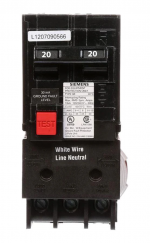mtnelect
HVAC & Electrical Contractor
- Location
- Southern California
- Occupation
- Contractor, C10 & C20 - Semi Retired
I dont know why no one in the US likes the idea of using ma trip levels like they do in the rest of the world.justification of the action.
Almost every state that has adopted the 2020 Edition of the NEC have modified or deleted
Section 210.8(F).
The NFPA has formed a Task Force to find out the problem of "Phantom Tripping" with DC conversion equipment, which is causing problems with HVAC units. Stay tuned for their findings. In the meantime the NFPA has given them until 2026 to find out.I love this part:
I dont know why no one in the US likes the idea of using ma trip levels like they do in the rest of the world.
I agree. The attitude of, "If it's not GFCI then someone is going to die" makes no sense to me. We could have less nuisance tripping, greater compliance, and safer electrical installs if GFPE level protection was expanded instead of requiring GFCIs everywhere they added in the last code cycle.I love this part:
I dont know why no one in the US likes the idea of using ma trip levels like they do in the rest of the world.
They can add the UK, France, Germany just about every other country that uses RCD's or what we call GFPE.Evidence of safe use in Japan with a different means of protection has
been documented.

It's more likely that a sick elderly person will die if their AC unit nuisance trips during a heat wave than someone dying from touching the unit. This is a horrible code change which indicates that some of the CMP were asleep at the wheel.
It's the all or nothing mentality that is pervasive in the culture of the code writing members that is the problem. We can't use GFPE level of protection because it's not safe enough compared to GFCI level protection even though it would be easier to implement and a huge improvement in electrical safety. It's aggravating and shameful.I love this quote in there also:
They can add the UK, France, Germany just about every other country that uses RCD's or what we call GFPE.
I am pretty sure the guts of these HVAC units are the same world wide.
All the major breaker manufacturers here make the class "b" gfci breakers so its not like they need to make a new breaker.
The real difference between GFPE and SPGFCI is the required time to trip. GPFE does not have any requirements for how long between the detection and a ground fault that the device opens. Special Purpose GFCIs (SPGFCI) do have a specified time to trip.It's the all or nothing mentality that is pervasive in the culture of the code writing members that is the problem. We can't use GFPE level of protection because it's not safe enough compared to GFCI level protection even though it would be easier to implement and a huge improvement in electrical safety. It's aggravating and shameful.
I thought the difference was the 5mA vs a higher level of ground fault current the device would sense before it opens.The real difference between GFPE and SPGFCI is the required time to trip. GPFE does not have any requirements for how long between the detection and a ground fault that the device opens. Special Purpose GFCIs (SPGFCI) do have a specified time to trip.
That is part of it, but the standard has no time to trip requirements for GFPE. SPGFCIs operate in the same 20 to 30 mA trip as many GFPEs, but even the trip current level is not specified for GFPE in the product standards.I thought the difference was the 5mA vs a higher level of ground fault current the device would sense before it opens.
Thats the point I think the CMP is missing.As seen with the RCDs used in other countries, a 30 mA trip can protect people with a quick enough trip time.

